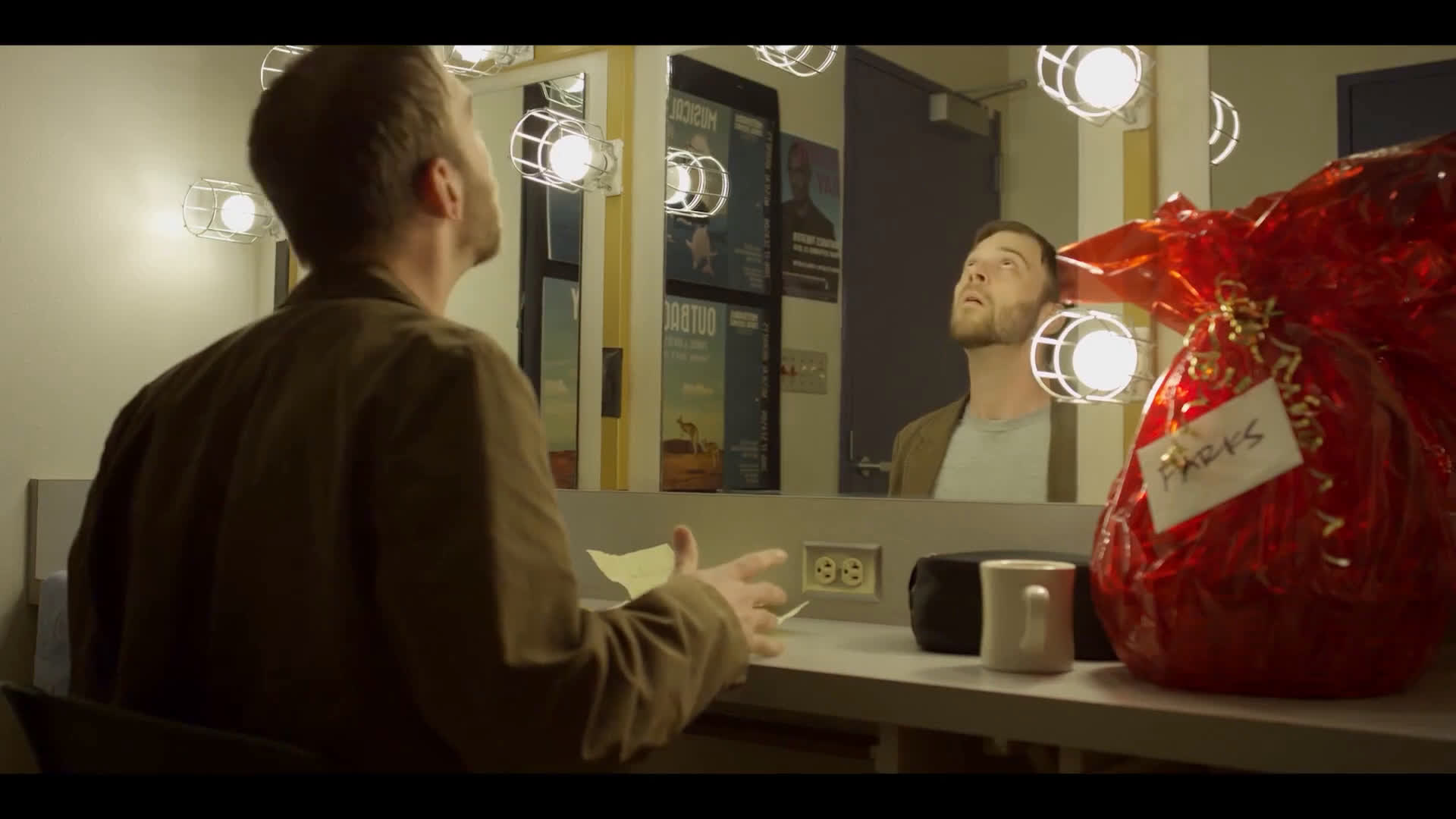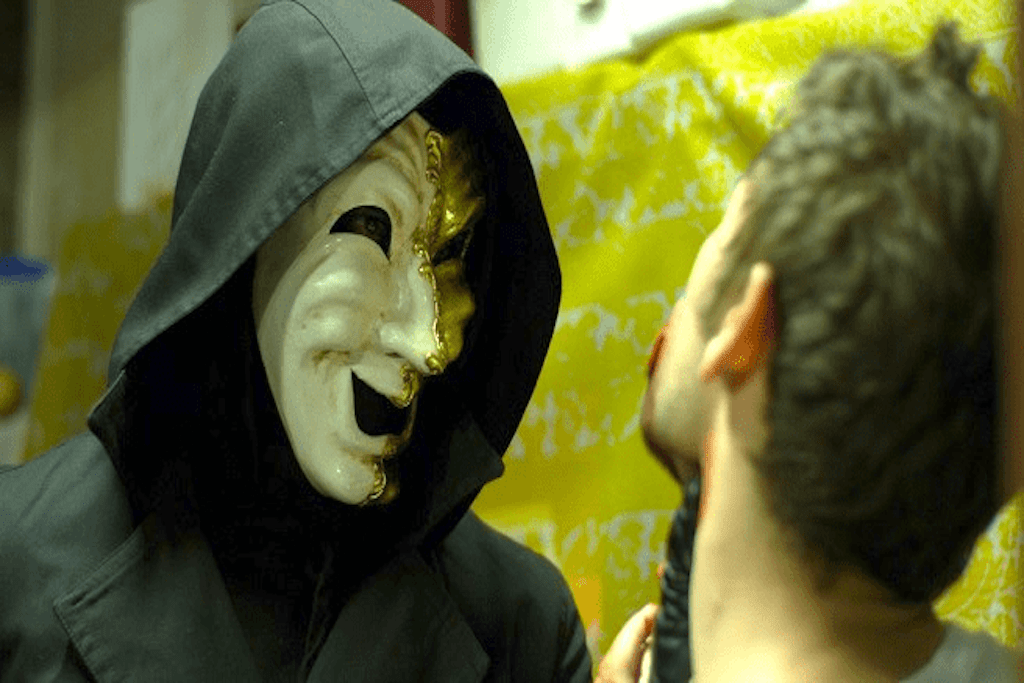Interview contains potential spoilers
The Last Laugh is part horror slasher,, part classic suspense and a bit irreverent comedy. Director Jeremy Berg’s third film is part modern theater drama with a bit of blood, murder and mystery.
Starring Steve Vanderzee as Myles, a stand-up comedian on the verge of a breakout performance forced to make career altering choices after discovering a body in his dressing room on the night of his biggest show to date. Lowell Deo stars as headline act and rival comic Reggie Ray with a unique list of suspects working behind the scenes before the show.
Berg says they filmed in two theaters, merging footage to create one location “We used the exteriors of the Pantages, everything in the auditorium, front of stage, the dressing rooms, prop room and green room. Everything behind the curtain, the backstage area, basement, some of the hallways and wreck area, that’s all filmed in a theater in North Seattle.
Someone with backstage access at Pantages would see the difference, “I struggled with the idea of filming at different theaters then splicing it together,” Berg says. “Is it gonna work? Are people gonna buy it’s all one theater? It seems to work pretty well together.”
The plot point about the theater closing was script only though the Pantages did close for remodeling, “When we went there it was good timing on our part. They were about to close for two years for renovations updating with new seats and other things. If we had pushed the filming dates up, we wouldn’t have filmed there because it would’ve been torn up. It will probably be open in a year from now.”
Viewers will have different reactions to the ending, “That’s the thing that gets some people for sure. The ending is as written, in the script.”
Several reveals were filmed, with other actors revealing themselves, done as a safety net including the idea of multiple killers adding to Myles’s fragile mental state via flashbacks. “At the end of the day we went with how it was written, it worked the best.”
The on screen audience sees something the viewer doesn’t filmed but edited out. It would’ve made a great scene and possible last shot but Berg felt it wasn’t up to par, due to limited filming days and budget.
The ending shown was something different that Berg hasn’t seen done too many times. “There’s a couple layers to why I did it that way. For me one reason, I like stand up and one reason I relate to them is I do have a sense of humor in places where it’s not always there. Sometimes the humor of a situation is what’s most important and Myles is a comedian.” He ends up in the worst case scenario, smiles and makes a joke about it. “It was more important to highlight that moment for him.”
There’s something fun about wondering who it might be. ”I sometimes get mad when a movie doesn’t give you anything to talk about. There’s some clues in there and things to play with and ultimately it’s Myles’s journey.” Some time’s the reveal can be a holy sh— moment, a WTF moment or just underwhelming. “All guesses are really fun.”
Concerning the killer’s identity, Berg liked the element in some films where motivations are found in different characters, so you’re not sure who it’s going to be. “We filmed a few shots of the actors pulling off the mask, Myles, was one of them. I think there’s enough pointing to him as the culprit. He’s having a psychological break.”
The last shot with the half open window panning across the exterior of the Pantages leaves questions open. “I watched it with a couple audiences.” Everyone pointed to a different window saying they saw something. “It’s a throwback to ‘70s horror with shots where you have to lean forward and pay attention. Not sure whether you trust your eye.”
The film is compared to a mix of Scream and Susperia. “I’d say there’s a bit of spiritual relation to the film. When I wrote it I was really pulling for Giallo films, the ‘70s slasher, psychological Italian horror. Susperia is probably the most known of those films. Though it breaks a little bit from the formula, it’s more about the environment she’s in and everyone around her is a culprit. I pulled a little more from Argento’s Deep Red. The kills are important and the suspense leading up to the kills. Something I tried to tap into and play with.”
Berg played more with the buildup and suspense to the murder, “For me that was more of the point. The sound effect and brutality are there. I’d say he was an efficient killer.”
 The Inspiration behind mask and costume came from the theater tradition. “The mask was an idea I had. One of the themes running through the story was the comedy and tragedy aspects of the theater.” He went comedy over tragedy for extra creep factor. “Tragedy would be too much on the nose, I think. He’s a comedian, playing into that as well. It felt really natural.” He even considered a split mask of comedy and tragedy. “I ended up ordering from an Italian mask maker, all handmade, a really beautiful piece of work.”
The Inspiration behind mask and costume came from the theater tradition. “The mask was an idea I had. One of the themes running through the story was the comedy and tragedy aspects of the theater.” He went comedy over tragedy for extra creep factor. “Tragedy would be too much on the nose, I think. He’s a comedian, playing into that as well. It felt really natural.” He even considered a split mask of comedy and tragedy. “I ended up ordering from an Italian mask maker, all handmade, a really beautiful piece of work.”
The killer’s costume had a utilitarian aspect giving them easy access to prowl the theater, unnoticed. Berg said going too theatrical would’ve been too obvious and silly.
There are scenes where the killer taps their knife on the door and basement pipe taunting Myles. The basement/boiler room scene gives off subtle Freddy vibes. “It would be there unintentionally. A Nightmare on Elm Street was a huge influence on me, as a kid. I was watching horror movies when I was too young to be watching horror movies. It’s a love affair that will never go away and really stuck with me. I’ve always had a love for that series and that character in particular.”
When Myles initially enters the theater there’s a wide shot showing the carpet creating a six-second Shining vibe. “The carpet was there so there wasn’t much we could do about it. The Shining’s definitely in my top three horror films. The carpet looking somewhat similar is definitely a happy accident but a very welcome one.”
Mid-film characters discuss the, in the script, theater legend of Laughing Linda. “One of the writers suggested it, maybe attributing the killings to her. I thought, oh, I’ve seen that in so many horror movies. Here’s the ghost story moment, not that I have a problem with those scenes. I generally like them but seen them so many times.” He initially wrote it thinking he didn’t want the scene. “I’m almost making fun of those scenes. Here’s the legend of the theater and Myles and the other character are making fun of her for the story. He says Laughing Linda’s a stupid name. When I approached it like that, I really liked it. We’re getting the legend while making fun of it. I think it works on a couple levels. It doesn’t make any sense, and not supposed to but it’s really funny.”
Earlier in the film, Myles practices his opening bit, telling a very offensive joke about his uncle’s secret habits. “I’m a huge fan of standup comedy. It’s a subculture that’s always interested me to explore in a horror setting. One thing I appreciate about stand up, there’s no filter. Comedians have license to make inappropriate jokes that are uncomfortable and it’s accepted. I didn’t want to shy away from it.” Writing PG material wouldn’t have fit him. “I didn’t want him to practice a monologue about pop tarts or something. It would be more in keeping with stand up in general if he did some inappropriate comedy.”
They filmed before 2020 happened. “We didn’t have to deal with any of that thankfully but have friends dealing with it right now. It’s definitely changed how things have to operate on set. There’s a lot more time taken with safety, precautions and everything sanitized. It’s a much bigger deal than when we filmed.”
 He watched all genres growing up. “I watched The Terminator everyday for a month, if not longer. I always felt it was such an amazing art form. I thought about writing movies or scripts but wasn’t sure what. Oddly enough a friend showed me a Kurosawa film, the Seven Samurai. I watched that and Yojimbo on the same day. I didn’t know what it was, but something clicked, saying I need to do this. From that point, it went from being a consideration to being something I jumped into heavily. I never regretted it. Making movies is a great experience but it’s a hard thing to do especially at the B-level. It’s such a process, everything you go through. The saying goes, if you knew how hard it would be you almost wouldn’t do it. When you do, do it, you get addicted because it’s such a great experience. When it works, it’s an incredible feeling.”
He watched all genres growing up. “I watched The Terminator everyday for a month, if not longer. I always felt it was such an amazing art form. I thought about writing movies or scripts but wasn’t sure what. Oddly enough a friend showed me a Kurosawa film, the Seven Samurai. I watched that and Yojimbo on the same day. I didn’t know what it was, but something clicked, saying I need to do this. From that point, it went from being a consideration to being something I jumped into heavily. I never regretted it. Making movies is a great experience but it’s a hard thing to do especially at the B-level. It’s such a process, everything you go through. The saying goes, if you knew how hard it would be you almost wouldn’t do it. When you do, do it, you get addicted because it’s such a great experience. When it works, it’s an incredible feeling.”
Berg’s really proud of everything the crew accomplished and how it looks. “There’s things I could nitpick but there’s a lot of wonderful moments in the film and things that play well. I’m really proud of everyone’s contributions. I think it looks great. I’m happy with it.”
The Last Laugh is Berg’s third film, with The Invoking and The Device, coming before. He’s also done cinematography for the Sasquatch themed Hunting Grounds.. Martingale, a crime thriller was directed last year with a delayed release due to COVID. His first love will always be horror.
He says with other genres you need a gimmick of who’s in it or what it’s about to interest people. With horror, its horror, people will come and watch because it’s horror, regardless of plot, cast or good or bad. It’s a dedicated fandom.





